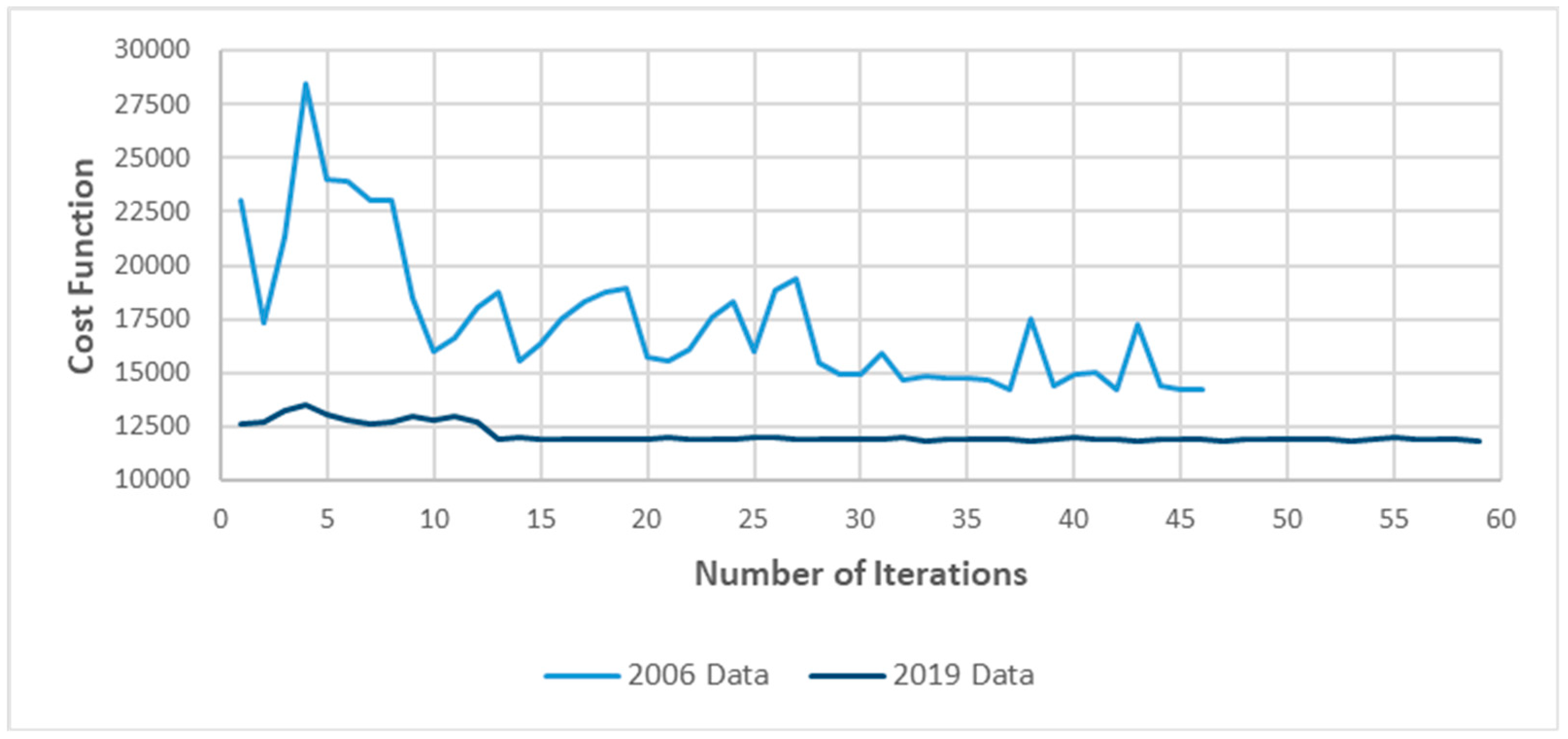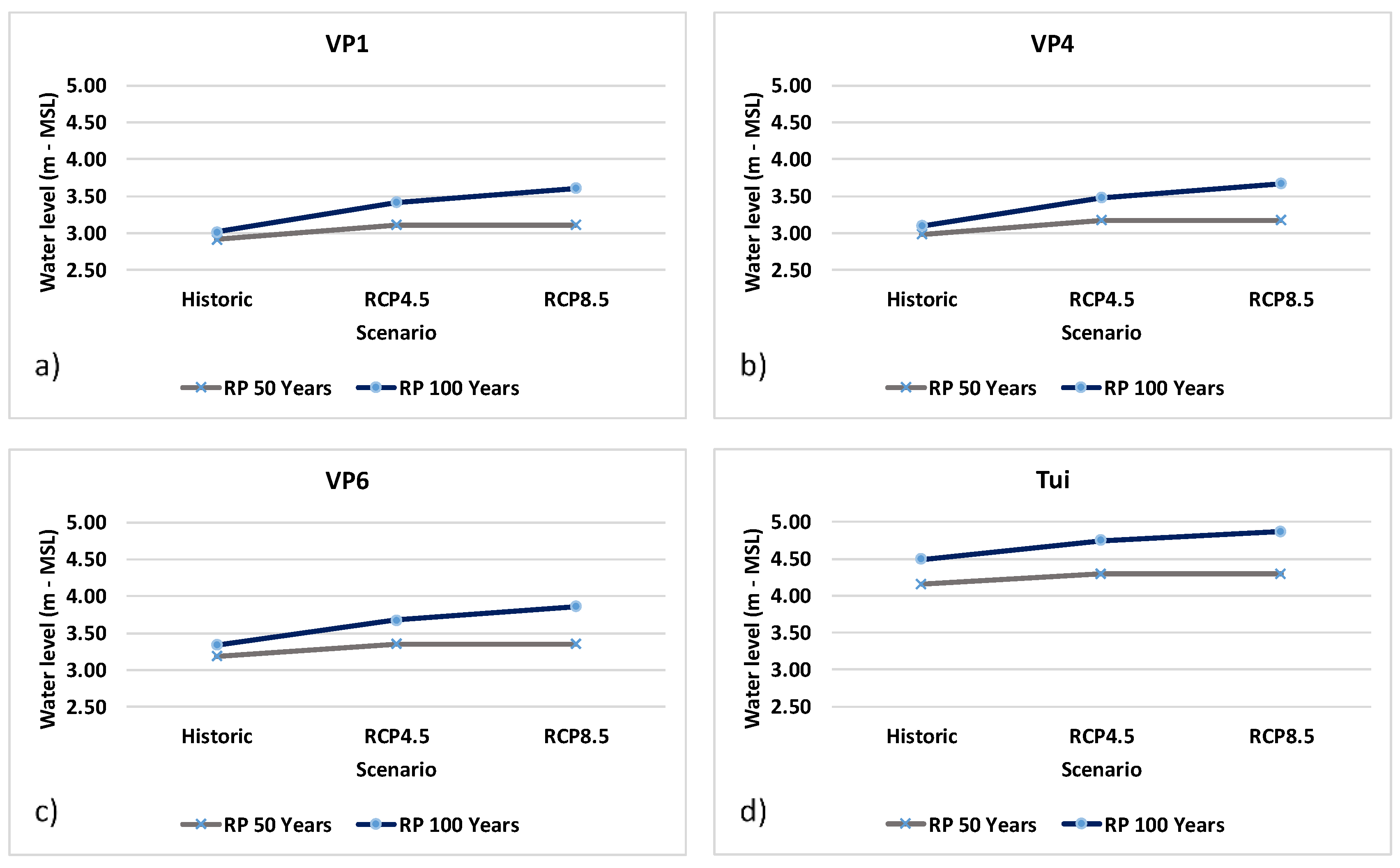Hydro- and Morphodynamic Impacts of Sea Level Rise: The Minho Estuary Case Study
Abstract
:1. Introduction
2. Study Area and Methods
2.1. Study Area
2.2. Methodological Approach
2.3. Numerical Model
2.4. Automatic Calibration Procedure
2.5. Climate Change Scenarios Definition
3. Results
3.1. Model Calibration Results
3.2. Hydrodynamic Results
3.3. Morphodynamic Results
4. Discussion
5. Conclusions
Author Contributions
Funding
Conflicts of Interest
References
- IPCC. Special Report on the Ocean and Cryosphere in a Changing Climate; IPCC: Geneva, Switzerland, 2019. [Google Scholar] [CrossRef] [Green Version]
- Kopp, R.E.; Kempd, A.C.; Bittermanne, K.; Hortonb, B.P.; Donnellyi, J.P.; Gehrelsj, W.R.; Haya, C.C.; Mitrovicak, J.X.; Morrowa, E.D.; Rahmstorfe, S. Temperature-Driven Global Sea-Level Variability in the Common Era. Proc. Nat. Acad. Sci. USA 2016, 113, E1434–E1441. [Google Scholar] [CrossRef] [PubMed] [Green Version]
- Dangendorf, S.; Wahl, T.; Hein, H.; Jensen, J.; Mai, S.; Mudersbach, C. Mean Sea Level Variability and Influence of the North Atlantic Oscillation on Long-Term Trends in the German Bight. Water 2012, 4, 170–195. [Google Scholar] [CrossRef]
- Miranda, L.B.; Castro, B.M.; Kjerfve, B. Principios De Oceanografia Fisica De Estuarios; Editora da Universidade de São Paulo: São Paulo, Brazil, 2012. [Google Scholar]
- Radović, V.; Iglesias, I. Extreme Weather Events: Definition, Classification and Guidelines towards Vulnerability Reduction and Adaptation Management; Springer: Cham, Switzerland, 2019; pp. 1–13. [Google Scholar] [CrossRef]
- European Comission. Guidelines on the Implementation of the Birds and Habitats Directives in Estuaries and Coastal Zones; European Comission: Brussels, Belgium, 2012. [Google Scholar] [CrossRef]
- Fenoglio-Marc, L. Analysis and Representation of Regional Sea-Level Variability from Altimetry and Atmospheric-Oceanic Data. Geophys. J. Int. 2001, 145, 1–18. [Google Scholar] [CrossRef]
- Iglesias, I.; Lorenzo, M.N.; Lázaro, C.; Fernandes, M.J.; Bastos, L. Sea Level Anomaly in the North Atlantic and Seas around Europe: Long-Term Variability and Response to North Atlantic Teleconnection Patterns. Sci. Total Environ. 2017, 609, 861–874. [Google Scholar] [CrossRef] [PubMed]
- Nerem, R.S.; Leuliette, É.; Cazenave, A. Present-Day Sea-Level Change: A Review. Comptes Rendus Geosci. 2006, 338, 1077–1083. [Google Scholar] [CrossRef]
- Karathanasi, F.E.; Belibassakis, K.A. A Cost-Effective Method for Estimating Long-Term Effects of Waves on Beach Erosion with Application to Sitia Bay, Crete. Oceanologia 2019, 61, 276–290. [Google Scholar] [CrossRef]
- Iglesias, I.; Venâncio, S.; Pinho, J.L.; Avilez-Valente, P.; Vieira, J.M.P. Two Models Solutions for the Douro Estuary: Flood Risk Assessment and Breakwater Effects. Estuaries Coasts 2019, 42, 348–364. [Google Scholar] [CrossRef]
- Deltares. Delft3D 4 Suite (Structured). Available online: https://www.deltares.nl/en/software/delft3d-4-suite (accessed on 7 February 2019).
- The OpenDA Association. OpenDA User Documentation. Available online: https://www.openda.org/docu/openda_2.4/doc/OpenDA_documentation.pdf (accessed on 16 June 2020).
- Leorri, E.; Fatela, F.; Drago, T.; Bradley, S.L.; Moreno, J.; Cearreta, A. Lateglacial and Holocene Coastal Evolution in the Minho Estuary (N Portugal): Implications for Understanding Sea-Level Changes in Atlantic Iberia. Holocene 2013, 23, 353–363. [Google Scholar] [CrossRef]
- Rovira, A.; Ballinger, R.; Ibáñez, C.; Parker, P.; Dominguez, M.D.; Simon, X.; Lewandowski, A.; Hochfeld, B.; Tudor, M.; Vernaeve, L. Sediment Imbalances and Flooding Risk in European Deltas and Estuaries. J. Soils Sedim. 2014, 14, 1493–1512. [Google Scholar] [CrossRef]
- Ribeiro, D.C.; Costa, S.; Guilhermino, L. A Framework to Assess the Vulnerability of Estuarine Systems for Use in Ecological Risk Assessment. Ocean Coast. Manag. 2016, 119, 267–277. [Google Scholar] [CrossRef]
- Iglesias, I.; Avilez-Valente, P.; Bio, A.; Bastos, L. Modelling the Main Hydrodynamic Patterns in Shallow Water Estuaries: The Minho Case Study. Water 2019, 11, 1040. [Google Scholar] [CrossRef] [Green Version]
- Rio-Barja, F.X.; Rodríguez-Lestegás, F. Os Ríos, in as Augas de Galicia. Cons. Cult. 1996, 178–180. [Google Scholar]
- Iglesias, I.; Avilez-Valente, P.; Luís Pinho, J.; Bio, A.; Manuel Vieira, J.; Bastos, L.; Veloso-Gomes, F. Numerical Modeling Tools Applied to Estuarine and Coastal Hydrodynamics: A User Perspective. In Coastal and Marine Environments-Physical Processes and Numerical Modelling; IntechOpen: London, UK, 2019. [Google Scholar] [CrossRef] [Green Version]
- APA, Agência Portuguesa do Ambiente. Plano de Bacia Hidrográfica Do Rio Minho; APA: Amadora, Portugal, 2001. [Google Scholar]
- Des, M.; DeCastro, M.; Sousa, M.C.; Dias, J.M.; Gómez-Gesteira, M. Hydrodynamics of River Plume Intrusion into an Adjacent Estuary: The Minho River and Ria de Vigo. J. Mar. Syst. 2019, 189, 87–97. [Google Scholar] [CrossRef]
- Siqueira, A.G.; Fiedler, M.F.M.; Yassuda, E.A. Delft3D Morphological Modeling Downstream of Sergio Motta Reservoir Dam. In IAEG/AEG Annual Meeting Proceedings, San Francisco, California, 2018-Volume 4; Springer: Cham, Switzerland, 2019; p. 4. [Google Scholar] [CrossRef]
- Team, Q.D. Quantum GIS Geographic Information System. Open Source Geospatial Foundation Project. Available online: http://qgis.osgeo.org2016 (accessed on 30 April 2020).
- Vasconcelos, M.; Botelho, H.; Kol, H.; Casaca, J. The Portuguese Geodetic Reference Frames. Iberia 1995, 95, 12. [Google Scholar]
- Hydraulics, D. Delft3D-RGFGRID. Generation and Manipulation of Curvilinear Grids for FLOW and WAVE. In User Manual; WL Delft Hydraulics, (Deltares): Delft, The Netherlands, 2005. [Google Scholar]
- Vieira, J.M.P.; Pinho, J.L.S.; Dias, N.; Schwanenberg, D.; Van Den Boogaard, H.F.P. Parameter Estimation for Eutrophication Models in Reservoirs. Water Sci. Technol. 2013, 68, 319–327. [Google Scholar] [CrossRef]
- González-Cao, J.; García-Feal, O.; Fernández-Nóvoa, D.; Domínguez-Alonso, J.M.; Gómez-Gesteira, M. Towards an automatic early warning system of flood hazards based on precipitation forecast: The case of the Miño River (NW Spain). Nat. Hazards Earth Syst. Sci. 2019, 19, 2583–2595. [Google Scholar] [CrossRef] [Green Version]
- Santos, M.A.; Rodrigues, R.; Correia, F.N. Technical Communication: On the European Water Resources Information Policy. Water Resour. Manag. 1997, 11, 305–322. [Google Scholar] [CrossRef]
- Vousdoukas, M.I.; Mentaschi, L.; Feyen, L.; Voukouvalas, E. Earth’s Future Extreme Sea Levels on the Rise along Europe’ s Coasts Earth ’ s Future. Earth’s Futur. 2017, 5, 1–20. [Google Scholar] [CrossRef]
- Stouffer, R.J.; Eyring, V.; Meehl, G.A.; Bony, S.; Senior, C.; Stevens, B.; Taylor, K.E. CMIP5 Scientific Gaps and Recommendations for CMIP6. Bull. Am. Meteorol. Soc. 2017, 98, 95–105. [Google Scholar] [CrossRef]
- Petroliagkis, T.I.; Voukouvalas, E.; Disperati, J.; Bidlot, J. Joint Probabilities of Storm Surge, Significant Wave Height and River Discharge Components of Coastal Flooding Events. European Commission Technical Reports, Italia. Available online: http//bookshop.Eur.eu/en/joint-probabilities-of-storm-surge-significant-wave-height-and-river-discharge-components-of-coastal-flooding-eventspbLBNA278242016,0KABstXJMAAAEjt5AY4e5L (accessed on 15 April 2020).
- Balsinha, M.J.; Santos, A.I.; Oliveira, A.T.C.; Alves, A.M.C. Textural Composition of Sediments from Minho and Douro Estuaries (Portugal) and Its Relation with Hydrodynamics. J. Coast. Res. 2009, 56, 1330–1334. [Google Scholar]
- Ray, R.D.; Foster, G. Future Nuisance Flooding at Boston Caused by Astronomical Tides Alone. Earth’s Futur. 2016, 4, 578–587. [Google Scholar] [CrossRef]
- Pinho, J.L.S.; Vieira, J.M.P.; Do Carmo, J.S.A. Hydroinformatic Environment for Coastal Waters Hydrodynamics and Water Quality Modelling. Adv. Eng. Softw. 2004, 35, 205–222. [Google Scholar] [CrossRef]
- Werner, M.; Schellekens, J.; Gijsbers, P.; van Dijk, M.; van den Akker, O.; Heynert, K. The Delft-FEWS Flow Forecasting System. Environ. Model. Softw. 2013, 40, 65–77. [Google Scholar] [CrossRef] [Green Version]
- Idier, D.; Rohmer, J.; Pedreros, R.; Le Roy, S.; Lambert, J.; Louisor, J.; Le Cozannet, G.; Le Cornec, E. Coastal Flood: A Composite Method for Past Events Characterisation Providing Insights in Past, Present and Future Hazards—Joining Historical, Statistical and Modelling Approaches. Nat. Hazards 2020, 101, 465–501. [Google Scholar] [CrossRef] [Green Version]













| Scenario | Return Period (years) | River Flow (m³/s) | Climate Scenario | Expected ESL (m) | Ocean Boundary Water Level |
|---|---|---|---|---|---|
| S01 | 50 | 5364.5 | Historical | 2.9 | Constant |
| S02 | 50 | 5364.5 | RCP 4.5 | 3.1 | Constant |
| S03 | 50 | 5364.5 | RCP 8.5 | 3.1 | Constant |
| S04 | 50 | 5364.5 | Historical | 0.0 | Variable—neap tide |
| S05 | 50 | 5364.5 | Historical | 0.0 | Variable—spring tide |
| S06 | 100 | 6037.7 | Historical | 3.0 | Constant |
| S07 | 100 | 6037.7 | RCP 4.5 | 3.4 | Constant |
| S08 | 100 | 6037.7 | RCP 8.5 | 3.6 | Constant |
| S09 | 100 | 6037.7 | Historical | 0.0 | Variable—neap tide |
| S10 | 100 | 6037.7 | Historical | 0.0 | Variable—spring tide |
| Scenario | Return Period (years) | River Flow (m3/s) | Climate Scenario | Expected ESL (m) | Ocean Boundary Water Level |
|---|---|---|---|---|---|
| M01 | - | 541.05 | Historical | 0.0 | Constant |
| M02 | 50 | 5364.50 | Historical | 2.9 | Constant |
| M03 | 50 | 5364.50 | RCP 4.5/RCP 8.5 | 3.1 | Constant |
| M04 | 100 | 6037.70 | Historical | 3.0 | Constant |
| M05 | 100 | 6037.70 | RCP 4.5 | 3.4 | Constant |
| M06 | 100 | 6037.70 | RCP 8.5 | 3.6 | Constant |
| M07 | - | 541.05 | Historical | 0.0 | Variable—neap tide |
| M08 | - | 541.05 | Historical | 0.0 | Variable—spring tide |
| Scenario | River Flow Discharge Return Period (years) | River Flow m³/s | Morphological Scale Factor | Expected ESL (m) |
|---|---|---|---|---|
| FB01 | - | 325.8 | 52 | 0.0 |
| FB02 | 50 | 5364.5 | 1 | 2.90 |
| FB03 | 100 | 6037.7 | 1 | 3.10 |
| FB04 | 50 | 5364.5 | 1 | −1.78 |
| Calibration Period | Observation Point | RMS | Mean RMS | Bias | Mean Bias | STD | Mean STD | Cost Function |
|---|---|---|---|---|---|---|---|---|
| 2006 | VP3 | 0.1846 | 0.2113 | −0.0876 | −0.1362 | 0.1626 | 0.1563 | 14,185.44 |
| VP4 | 0.2380 | −0.1848 | 0.1501 | |||||
| 2019 | Tui | 0.3385 | 0.2696 | −0.1401 | −0.0932 | 0.3085 | 0.2520 | 11,845.64 |
| Goian | 0.2007 | −0.0462 | 0.1955 |
| Parameter | Value | Parameter | Value |
|---|---|---|---|
| M2 amplitude (m) | 0.557 | K2 amplitude (m) | 0.082 |
| M2 phase angle (degrees) | 73.953 | K2 phase angle (degrees) | 102.482 |
| S2 amplitude (m) | 0.169 | Horizontal eddy viscosity (m2/s) | 3.000 |
| S2 phase angle (degrees) | 118.549 | Upper estuary Manning coefficient (m−1/3·s) | 0.019 |
| N2 amplitude (m) | 0.178 | Lower estuary Manning coefficient (m−1/3·s) | 0.026 |
| N2 phase angle (degrees) | 55.391 |
| Scenario | Tidal Amplitude as Percentage of the Amplitude at VP1 (%) | ||
|---|---|---|---|
| VP4 | VP6 | Tui | |
| S04 (Spring tide, flood peak discharge for RP 50 years) | 81 | 49 | 27 |
| S05 (Neap tide, flood peak discharge for RP 50 years) | 81 | 45 | 23 |
| S09 (Spring tide, flood peak discharge for RP 100 years) | 79 | 45 | 23 |
| S10 (Neap tide, flood peak discharge for RP 100 years) | 78 | 42 | 22 |
© 2020 by the authors. Licensee MDPI, Basel, Switzerland. This article is an open access article distributed under the terms and conditions of the Creative Commons Attribution (CC BY) license (http://creativecommons.org/licenses/by/4.0/).
Share and Cite
Melo, W.; Pinho, J.; Iglesias, I.; Bio, A.; Avilez-Valente, P.; Vieira, J.; Bastos, L.; Veloso-Gomes, F. Hydro- and Morphodynamic Impacts of Sea Level Rise: The Minho Estuary Case Study. J. Mar. Sci. Eng. 2020, 8, 441. https://doi.org/10.3390/jmse8060441
Melo W, Pinho J, Iglesias I, Bio A, Avilez-Valente P, Vieira J, Bastos L, Veloso-Gomes F. Hydro- and Morphodynamic Impacts of Sea Level Rise: The Minho Estuary Case Study. Journal of Marine Science and Engineering. 2020; 8(6):441. https://doi.org/10.3390/jmse8060441
Chicago/Turabian StyleMelo, Willian, José Pinho, Isabel Iglesias, Ana Bio, Paulo Avilez-Valente, José Vieira, Luísa Bastos, and Fernando Veloso-Gomes. 2020. "Hydro- and Morphodynamic Impacts of Sea Level Rise: The Minho Estuary Case Study" Journal of Marine Science and Engineering 8, no. 6: 441. https://doi.org/10.3390/jmse8060441
APA StyleMelo, W., Pinho, J., Iglesias, I., Bio, A., Avilez-Valente, P., Vieira, J., Bastos, L., & Veloso-Gomes, F. (2020). Hydro- and Morphodynamic Impacts of Sea Level Rise: The Minho Estuary Case Study. Journal of Marine Science and Engineering, 8(6), 441. https://doi.org/10.3390/jmse8060441






